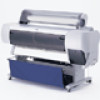Epson Stylus Pro 10000 - Archival Ink Technical Brief (EPSON Archival Inks) - Page 3
Greater durability, Unprecedented gloss for RC Resin Coated Photographic Prints - printer ink
 |
View all Epson Stylus Pro 10000 - Archival Ink manuals
Add to My Manuals
Save this manual to your list of manuals |
Page 3 highlights
Technical Brief-EPSON Archival Inks Page 3 2. Greater durability: With EPSON MicroCrystal Encapsulation Technology, the resin pulls the pigment into the crevices of the media. Because the pigments reside in the crevices of the media, prints are more scratchresistant. EPSON's MicroCrystal Encapsulation Technology: Conventional Pigment Inks: Pigments are fixed on specialty media by the polymerizing resin and are more durable and scratch-resistant Pigments lay on top of the media and are easily scratched ▲ ▲ ▲ ▲ Stability of Pigment Inks and Dye Inks: Pigment inks provide higher short-term stability because they have much faster setting time than dye-based inks, which results in a lesser color shift. Short-Term Color Shift (or Setting Time) 6 .0 Key: Dye inks 5 .0 Pigment inks 4 .0 Delta E 3 .0 2 .0 1 .0 0 .0 0 20 40 60 80 100 120 140 Hours After Printing A rating less than 3% delta is only noticeable to the trained eye. A rating less than 2% delta is unnoticeable to the human eye. 3. Unprecedented gloss for RC (Resin Coated) Photographic Prints: EPSON RC media is specially designed to provide the highest gloss with the EPSON Archival Inks. Un-Optimized Media: If third-party fine art papers are used, pigments will penetrate the media, but may go too far into the crevices, resulting in lower gloss Optimized Media: EPSON RC media allows the pigment particles to penetrate the paper but keeps them close to the surface for the highest gloss Light Light EPSON Sales Training Media (Cross-Section) Media (Cross-Section) Additionally, third-party fine art papers are not recommended for use because they may damage the printers with excessive dust. EPSON offers a variety of media compatible with the Archival Inks. EPSON and EPSON Stylus are registered trademarks of Seiko Epson Corporation. Other trademarks are the property of their respective owners. 11/00







